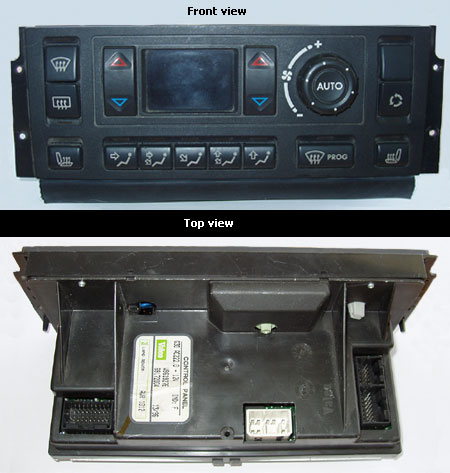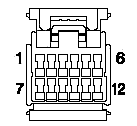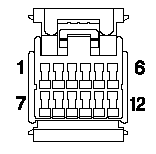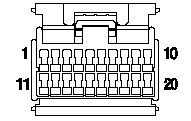Realtime live display of the information the electronic control unit of the selected vehicle system is currently deriving from its input sensors.
SWITCHES
- Left heat down: This gives the current status of the user's button mounted on the face of the Hevac ECU, allowing its correct operation to be tested.
- Left heat up: This gives the current status of the user's button mounted on the face of the Hevac ECU, allowing its correct operation to be tested.
- Right heat down: This gives the current status of the user's button mounted on the face of the Hevac ECU, allowing its correct operation to be tested.
- Right heat up: This gives the current status of the user's button mounted on the face of the Hevac ECU, allowing its correct operation to be tested.
- Demist program: This gives the current status of the user's button mounted on the face of the Hevac ECU, allowing its correct operation to be tested.
- Front screen: This gives the current status of the user's button mounted on the face of the Hevac ECU, allowing its correct operation to be tested.
- Rear screen: This gives the current status of the user's button mounted on the face of the Hevac ECU, allowing its correct operation to be tested.
- Left heated seat: This gives the current status of the user's button mounted on the face of the Hevac ECU, allowing its correct operation to be tested.
- Right heated seat: This gives the current status of the user's button mounted on the face of the Hevac ECU, allowing its correct operation to be tested.
VENT SWITCH STATES
- Face: This gives the current status of the user's button mounted on the face of the Hevac ECU, allowing its correct operation to be tested.
- Face and feet: This gives the current status of the user's button mounted on the face of the Hevac ECU, allowing its correct operation to be tested.
- Feet: This gives the current status of the user's button mounted on the face of the Hevac ECU, allowing its correct operation to be tested.
- Feet and screen: This gives the current status of the user's button mounted on the face of the Hevac ECU, allowing its correct operation to be tested.
- Screen: This gives the current status of the user's button mounted on the face of the Hevac ECU, allowing its correct operation to be tested.
- Recirculation: This gives the current status of the user's button mounted on the face of the Hevac ECU, allowing its correct operation to be tested.
- Air con off: This gives the current status of the user's button mounted on the face of the Hevac ECU, allowing its correct operation to be tested.
- Automatic: This gives the current status of the user's button mounted on the face of the Hevac ECU, allowing its correct operation to be tested.
- Fan speed: This gives the numeric value for the currently selected fan speed which should change in even steps from 1 to 10 when the speed adjuster is rotated from one extreme to the other.
SENSORS
- Ambient temperature: This reading gives the external air temperature or air entering the ventilation system.
- Aspirator temperature: This reading gives internal cabin temperature.
- Evaporator temperature: This reading gives the evaporator unit's temperature.
- Heater core temperature: This reading gives the engine coolant temperature where the coolant enters the heating system.
- Road speed: This value is generated by the ABS ECU using information from its wheel rotation sensors.
- Solar sensor (w/sqm): This reading gives the effective strength of the sun as detected by the Solar Sensor mounted beside the Alarm LED on the top of the dashboard.
- Distribution motors: This gives the current feedback position of the motor that drives the flap controlling air distribution inside the vehicle. As the distribution buttons are pressed the flap should move to the position which gives air flow to the selected direction (feet, face, screen etc.).
- Left blend motor: This gives the current feedback position of the motor which drives the flap controlling amounts of hot and cold air to be blended together (effectively the temperature of the air coming out of the vents). As the requested temperature is changed by the user the flap should move.
- Right blend motors: This gives the current feedback position of the motor which drives the flap controlling amounts of hot and cold air to be blended together (effectively the temperature of the air coming out of the vents). As the requested temperature is changed by the user the flap should move.
- Left blower return: This is the feedback value returned back to the Hevac ECU from the left blower motor, used by the ECU to determine the actual voltage at the motor. This reading value also allows the Hevac ECU to detect Blower motor faults.
- Right blower return: This is the feedback value returned back to the Hevac ECU from the right blower motor, used by the ECU to determine the actual voltage at the motor reading. This value also allows the Hevac ECU to detect Blower motor faults.
- Air conditioning grant: When the A/C button is pressed an active low signal is output to the engine management ECU (The Request). This then looks at factors like engine temperature, load, current acceleration etc. and according to when these conditions allow, grant Air conditioning. This involves it engaging the clutch to drive the Air Conditioning pump, altering its internal fuelling to compensate for the load imposed by the pump, managing along with the Hevac the Condenser fans, and also telling the Hevac that Air Conditioning has been granted.
|
 VALEO HEVAC (P38 NRR) - System Overview
VALEO HEVAC (P38 NRR) - System Overview VALEO HEVAC (P38 NRR) - Known Fitments
VALEO HEVAC (P38 NRR) - Known Fitments VALEO HEVAC (P38 NRR) - Physical Details
VALEO HEVAC (P38 NRR) - Physical Details
 VALEO HEVAC (P38 NRR) - Pin Outs
VALEO HEVAC (P38 NRR) - Pin Outs 12 pin black
12 pin black  8 pin white
8 pin white  (no A/C)
(no A/C) (with A/C)
(with A/C)